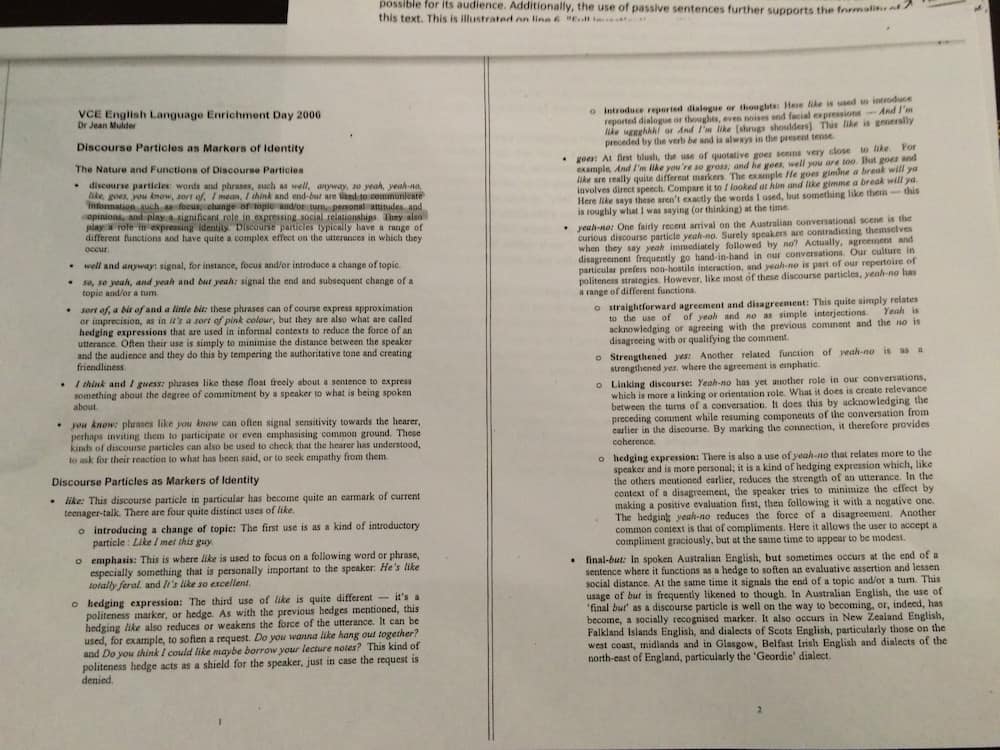As the exam is only a couple of weeks away, it's important that you begin to finalise your knowledge of key content in the study design.
In Practical English Usage, Michael Swan defines a 'discourse marker' as 'a word or expression which shows the connection between what is being said and the wider context'. For him, a discourse marker is something that either connects a sentence to what comes before or after or indicates a speaker's attitude to what he is saying. The main reasons include the following:
- to provide a sense of where something is in relation to something else;
- to supply a sense of when something is happening;
- to compare two ideas and express similarities;
- to contrast ideas English provides many examples to signal the notion of difference;
- to present additional or supplementary ideas;
- to indicate that a point in a discussion has been conceded or already taken into account;
- to demonstrate a sense of logical sequence;
- to offer an illustration or an example;
- to deliver a summary of the ideas discussed.
Examples include: "well", "now", "then", "you know", "I mean", "like", "I think", "anyway" and "yeah nah".
To put these into context, I have attached a photo of a sheet that I discovered a few years ago on the various functions.

Lenore and Alina have met for a coffee and are discussing an acquaintance.
1 LENORE: [Disgusting].
2 ALINA: [(TSK) Well you know],
3 LENORE: (Hx)
4 ALINA: remember ^Tyke?,
5 .. Lived next door to Mom?.
6 LENORE: .. (%) ... Yeah:.
7 ALINA: ... Okay.
8 (H) .. Two weeks ago I'm watching TV,
9 .. and David Horowitz is going to have,
10 this former car .. radio thief on?.
11 LENORE: ... It's her boyfriend?.
12 ALINA: (H) .. Yeah,
13 her ex-boyfriend.
14 ... ^Mike.
15 ... He's the one that stole ~Hector's radio.
16 LENORE: ... How do you know.
17 ALINA: (H) Well,
18 ... cause well,
19 .. he —
20 .. he was a cocaine addict.
21 So he's talking about,
22 #he —
23 <VOX> #you #know he's,
24 yeah man,
25 he's gonna show us,
26 .. you know,
27 how # not #,
28 LENORE: (THROAT)
29 ALINA: to protect your car,
30 not to get it,
31 you know,
32 ripped off man.
33 Cause,
34 you know,
35 I —
36 .. yeah,
37 I was into it,
38 uh let me show you how easy it was </VOX>.
39 (H) He's actually pretty intelligent.
40 .. You know he just —
41 ... (H) uneducated,
42 so,
43 .. u:m,
44 .. (TSK) yeah:.
45 ~Hector's radio:,
46 with —
47 I– it was bro:ken,
48 we were gonna s– —
49 take it out and send it back to the factory,
50 to get a new factory,
51 .. (H) radio,
52 we never got a chance,
53 because,
54 the back window was broken,
55 and they stole #it.
56 ... The radio.
57 ... And you can't send something back to the factory,
58 that isn't there any[more],
59 LENORE: [<WH> @@@ </WH>]
60 ALINA: right?,
61 .. So he never got his [radio.
62 LENORE: [It's really hard.
63 ALINA: (H):]
64 LENORE: <WH> Oh.
65 Shit </WH>].
66 ALINA: So he got another radi[2o this] summer,
67 LENORE: [2(H):]
68 ALINA: but of course that got ripped off also.
69 <VOX> But never mind </VOX>.
70 (Hx[:])
71 LENORE: [He's #having] bad luck with that car.
Thanks! I sincerely hope this helps!
Dmitri
About Learnmate
Learnmate is a trusted Australian community platform that connects students who want 1:1 or small group study support, with tutors who are looking to share their knowledge and earn an income. From primary school to high school subjects — from science and maths to niche subjects like visual communication — Learnmate can help you improve academic performance or boost confidence, at your pace with the tutor that you choose.
Students and parents can easily find and screen for tutors based on their location, their subject results or skill level, and whether they provide in-person or online sessions. Learnmate is proud to provide tutors in Melbourne, Sydney, Geelong, Brisbane, Hobart, Canberra, Perth & Adelaide, and other locations.



